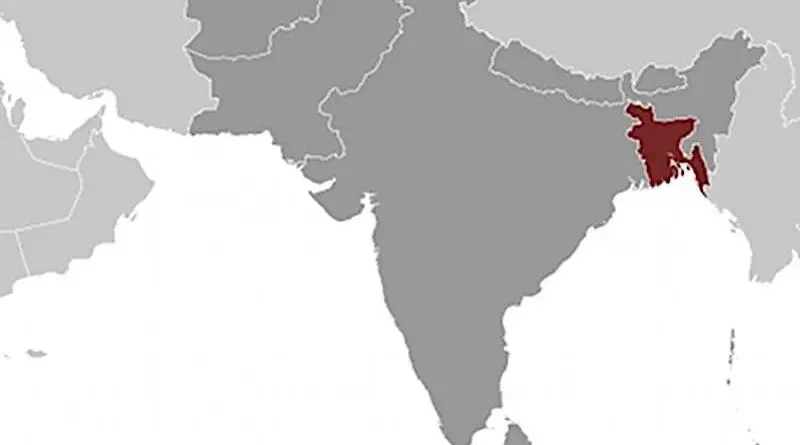Bangladesh’s Shaheed Hamja Brigade – Analysis
By Dr. Bibhu Prasad Routray and Mantraya
Shaheed Hamja Brigade (SHB) is the newest addition to Bangladesh‘s terror formations. The authorities believe that following the arrest of 25 of its cadres, the outfit has been neutralised. Yet, a number of questions regarding SHB’s nexus with persons and networks need to remain to be answered.
Sometime in the month of November in 2013, a group of Islamists met at a hotel in Chittagong’s Foy’s Lake area. An hour-long brain storming in the Bangladeshi port city led to the formation of the ‘Shaheed Hamja Brigade’ with a purported objective of fighting against the “worldwide oppression against the Muslims”. The founding cadres kept the formation of the new outfit well under wraps until a freak arrest in February 2015 that trapped 12 SHB cadres. Since then, a series of raids by the Rapid Action Battalion (RAB), Bangladesh’s elite counter terrorism force with a range of achievements to its credit in the past years, have led to the arrest of 25 SHB cadres. While the operation of a new Islamist militant outfit has come to the limelight, a lot many questions regarding the nexus SHB shares with persons and networks outside and inside Bangladesh is yet to be answered.
Following the November 2013 meeting, the SHB’s founding members went on a recruitment drive. They managed to attract some students from Qawmi madrassas, public and private universities, brainwashed them and later trained in a militant training camp. The arrested SHB members told the RAB of their education in a madrassa of Hathazari sub-district and subsequent training in arms handling in a hilly area of Banshkhali sub-district. SHB grew to be at least 50-member strong, with each SHB member trained to be, as per RAB’s description, an ‘one man army’, “preparing physically and mentally to conduct militant activities in the country and abroad.” SHB was divided into three factions – Green, Blue and White – each consisting of seven men. The outfit also created a media wing.
On 19 February, RAB arrested 12 SHB militants at Al Madrasatul Abu Bakar in Hathazari and recovered laptops, memory cards and other audio-video materials, all part of SHB’s training schedule. Two days later, based on their interrogation, five militants, all in the age group of 22 to 25, were arrested from a training camp in the Lotmoni hills of Banshkhali along with arms and ammunition. The recovered videos contained clippings of operations by Jihadists across the world. The camp had the façade of an animal farm. Local sources indicated that a person named Moulana Mobarak had taken the hill on a lease in 1991 and was farming various animals, making the hill out of bounds for the locals.
Another raid on 28 February led to the arrest of four militants from a house in densely populated Bashundhara Residential Area of Chittagong. In the past Bashundhara Residential Area has been a favourite hiding place for militants of the Jamaatul Mujahideen Bangladesh (JNB) and thieves alike. Seizures included 76 handmade grenades, 150 kilograms of explosives, 30 types of bomb-making equipment and 24 rounds of shotgun ammunition. Soon after the raid, RAB chief Benazir Ahmed told a press conference that “an entire army battalion could have been equipped with the explosives that had been recovered”. Documents and books on jihad by Islami Chhatra Shibir, student wing of the Jamaat-e-Islami, a radical Islamist political party with a dubious past in Bangladesh’s war of liberation were also recovered. All the arrested had been trained in operating firearms, assembling and using explosives, and on how to evade detection.
About two months later, on 12 April, RAB arrested four persons from a hotel and another private house in Chittagong. The arrested included three SHB members, all in their twenties and an arms smuggler. Five AK-22 rifles, five pistols, one smooth bore breech loading rifle, a gun, 10 magazines of AK-22, five magazines of the pistols, and 3,668 bullets were recovered from the arrested. The AK-22 rifles were made in China. RAB also claims that the pistols in possession of SHB cadres were from India, smuggled into the country through the Comilla border, adjoining the Indian state of Tripura.
All the while, in the past one and half years, Chittagong remained SHB’s base, exploiting the city’s notorious past as a hub of small arms smuggling and the ease it provides to militant groups to lay their hands on weapons without having to receive them through a tedious and risky transport process. The recovery of sophisticated arms from the SHB cadres also points at its fairly comfortable financial status, supported by yet to be known financiers inside and outside the country.
With its purported objective of fighting against “worldwide oppression against the Muslims”, SHB can be interpreted as an outfit with a predominantly external agenda. Yet as the past demonstrates, groups with such outward manifestos have hidden domestic agendas against Bangladeshis with secular worldviews. An editorial Daily Star summed up, “While we applaud the efforts of law enforcements in apprehending this militant group,… We have reasons to believe that there may be more militant groups in the country that are evading detection of law enforcement agencies and operating in remote areas.”
Arrests of 25 cadres, fifty percent of SHB’s known strength, could have proved to be a serious setback to the outfit’s agenda. However, important questions regarding the financiers of the outfit remain, also the linkages SHB shares with other local and international groups.
Bibhu Prasad Routray is Director of Mantraya, where this article was published.

